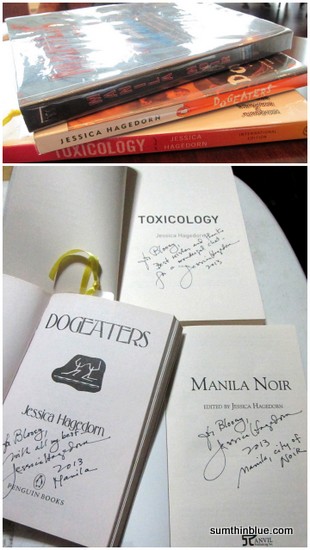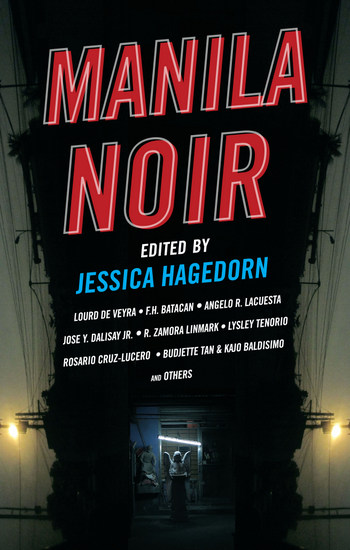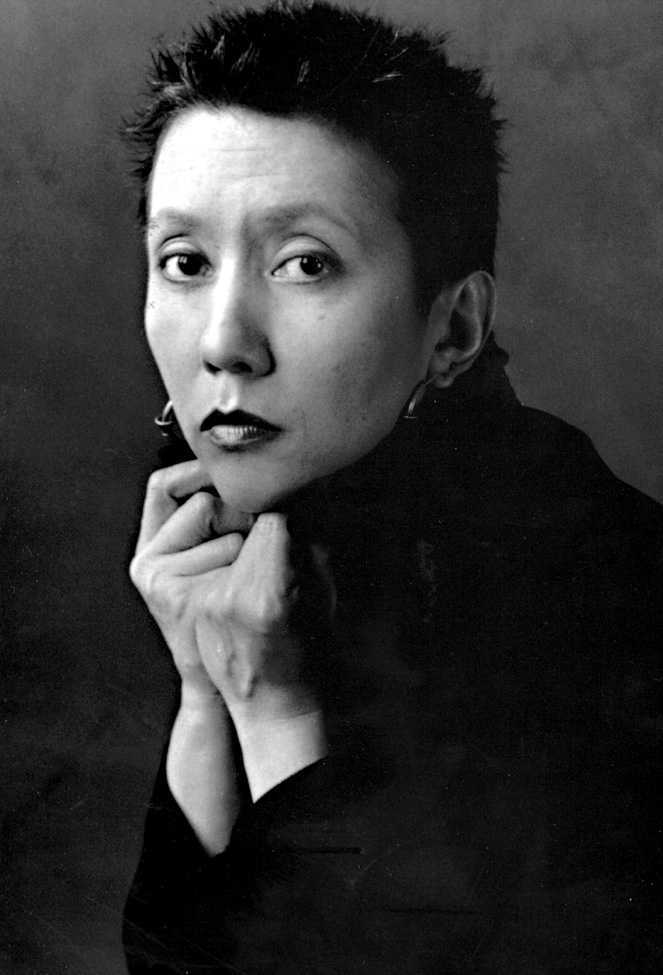I’d been looking forward to the launch of the anthology, “Manila Noir” for weeks, not only because I enjoyed reading the book, but also because a good number of the contributors were slated to appear, and it was a rare opportunity for a spectacular gathering of Filipino writers.
“Manila Noir” is a collection of stories depicting the city as an ideal setting for the noir genre. It is one volume of Akashic Books’ Noir series, an acclaimed series of original noir anthologies set in different cities all over the world, locally published by Anvil Publishing. “Manila Noir” is edited by Jessica Hagedorn, with stories by Lourd de Veyra, F.H. Batacan, Angelo Lacuesta, Jose Dalisay, R. Zamora Linmark, Lysley Tenorio, Rosario Cruz-Lucero, Budjette Tan & Kajo Baldisimo, Marianne Villanueva, and many more.
Before the launch at the National Book Store flagship in Glorietta 1, though, I had a lovely chat about the book (and other things) with Jessica Hagedorn herself, over at the Writer’s Bar in Raffles Fairmont. Below is a transcript of the interview.
On Manila Noir
Q: How did “Manila Noir” come about?
A: I’m a fan of noir fiction and film, and I have been reading a lot of the books that are in the Akashic international cities of noir series. I think it’s a brilliant concept, so when I finished reading “Mexico City Noir,” which I found to be one of their best selections, it reminded me so much of what I could do with a city like Manila.
It was so inspiring that I went to the editor in chief, Johnny Temple, and I pitched him the idea. I said, “It’s time for you to deal with Southeast Asia,” and he was very intrigued. I had no problem convincing him of the possibilities of the project.
Q: How were the contributors chosen?
A: The writers were chosen by me, by invitation, because I was the editor without help. The turnaround for these books is very fast, so you don’t have time to be shaping a story with a writer and all that… You need writers who already know what they’re doing. One of series requirements is that each story has to be an original, never before published, so the writers that I select have to deliver a story that’s well written in a short amount of time.
With that in mind, there were certain writers I already knew I wanted in the book. I also wanted some writers who were new to me, so I asked writer friends in the Philippines and the US, Fil-am writers who come here a lot, to recommend the new writers. Then I have friends who come here all the time, and I said to them, “Oh, so when you’re there, can you pick up the books by…” and I gave them a listahan… And I read the work and some of the writers are the ones who ended up with the book.
Q: What guidelines did you provide the writers?
A: They [the stories] had to be a certain length; there were only 14 of them. 20 pages maximum, they could be shorter. No happy endings. Lean and mean. They were all sophisticated writers. They knew what crime fiction meant, and that it had to have depth. It wasn’t like I had to tell them that much.
Q: How did the the writers choose which parts of the city they were going to highlight in their stories?
A: The second requirement of the Noir series is that the city becomes like a character. Each story had to be set in a different neighborhood. I told them, “Choose your neighborhood first. Let me know as soon as you know what it is.” Because some people, like me, when I wrote my story, had two neighborhoods they were interested in. I said, “Choose one right away so the others can be freed up for the other writers.”
Q: With the writers located in Manila and the US, was the geographical constraint a challenge?
A: Some people, you had to nag them. Some people were teaching, or have such busy lives. Like Lourd, who wears many hats. I’d email and say, “Let me know how much more time you need.” Editing by email is always a challenge. It’s easy for me to call a Fil-am writer in the US and clarify what I meant in my email. It’s hard to do that with the writers here, so I had to be extra judicious in how I wrote my email because they don’t know me; they can’t hear my voice. But we got through it, and everyone was so gracious and generous.
Q: What do you think sets Manila Noir apart from the other books in the Noir series?
A: All them [the books in the series] are different. I’m not in a contest about who has the most exciting city. But I think this is one of the most thrilling, personally. It’s up to the reader to decide if they think it’s as juicy as I think it is. I think it delivers a great array of writers. I think the book has turned out to be one of those that’s gotten a lot of attention, most unique especially with the inclusion of the graphic story, which is a surprise. There’s an extra treat there. It’s the only one with the graphic story, and I love it. I’m glad I went with my instincts on that. I’m just very proud to have the book included with all these other fine Noir books.
Q: What do you hope readers, Filipino or otherwise, would take away from reading the book?
A: That they would find it gripping and entertaining and eye-opening. If they’re not familiar with Manila, [that] they become more curious about it. Because we’re gonna get all kinds of readers. I think the experience for local readers is going to be very different for a reader who’s just curious, who loves noir and will pick up the book. I hope that people just really enjoy it, and the range of writing in it.
On Dan Brown, Manila, reading and writing
Q: Curiously, your book came out right on the heels of Dan Brown’s latest novel, which describes Manila as “the gates of hell.” What did you think about this?
A: I laughed… I don’t read him; I think he’s a terrible writer. I just think it’s funny. I understand why people got upset. I think people shouldn’t give him that much importance.
But it actually turned out great for your book, because people were buying it in response to Dan Brown.
(Laughs). That’s good. Thank you, Dan Brown! But I also know people probably bought his book because people wanted to see what Dan Brown had to say. It sells books when people get upset. You’re kind of helping him along. But I wouldn’t take him seriously.
Q: What is the one thing you love about Manila?
A: Well, it’s where I grew up, so it’s always going to be an important landscape to me. I think that Manila is just so intense. I love the intensity. Something’s always happening in front of you. It’s visually very amazing to me — there’s life going on all around.
Q: As a writer, is it a conscious decision for you to write stories about the Philippines, with Filipino characters?
A: If it works for the story… I don’t make a big deal out of it, for myself. It’s who I am, it’s not something weird.
Q: How would you describe your writing process?
A: I think the first draft is always the hardest. You’re just letting the story sort of unfold, and that’s when you’re struggling and figuring out if this character is interesting enough. By the time you’re in your second, third, fourth rewrite, and you kind of know what the story is you’re following, then it becomes about shaping the story and developing the characters in a much deeper way, and making the dialogue pop. I think the revision part is the more fun part forever, and the first phase of it is the difficult, but that’s what every writer has to confront. I pretty much just do it. If I’m under a deadline, I just focus. I don’t go out, it’s like I go into a trance with my work. I just get it done. It takes a lot of discipline.
Q: What would you advise Filipino writers about keeping the Filipino identity in their work?
A: So do it. If they want to write about the Philippines, they should. If they don’t want to write about the Philippines, it’s their right.
Q: Who are your favorite authors, local and international?
A: I’ve really found new authors to enjoy by doing this collection. I’m really happy that this project led me to authors I’d never read before, like Lourd, and Sarge Lacuesta. I would say Budjette and Kajo, I find that kind of work very compelling. I’ve always loved Jose Dalisay’s work; I think he’s a masterful writer of short stories, one of the Philippines’ living masters. Rosario Lucero is new to me so I was really happy to work with her. And I love F.H. Batacan, I hope she keeps writing about this priest,this forensic anthropologist. I think it’s a brilliant concept. She should make a series. I’m really encouraging her to do that, because I want to keep reading him. He’s a great character.
Roberto Bolaño is my absolute favorite.
Oh, I’ve read 2666.
You did? I love that book. I teach a course on Bolaño, as well as an MFA program in a university in Brooklyn, it’s a creative writing program. I teach a fiction workshop, I also teach playwriting. That’s my other love.
Q: Speaking of plays, how was your experience like, seeing Dogeaters turned into a play?
A: I love it. I love the theater. That’s one of my passions. And I love writing for the theater, so to adapt that book was a great experience. And working with all those actors — actors here, actors in LA, actors in New York — what a privilege. It’s a different experience every time. It kind of makes you relive the novel in a fresh way. That’s really the fun of it.
Q: How do you feel about ebooks?
A: Technology — you just have to accept that it’s part of the landscape now. I’m still a book buyer, but I get why people are drawn to it. It’s cheaper, and traveling here, I had my iPad so I went to the free classics and I downloaded them. So I get it. But what did I do? I get all that, and I brought a book in the end. So there. I like holding a book with my hands. But I think ebooks are here to stay, and I think there will always be people who like going to bookstores and picking up a book. It’s just sexier, I’m sorry. Downloading is like, a convenience, but it’s not interesting to me.
Q: What are you working on right now?
A: I’m sort of in gestation mode. Thinking of this new piece. Maybe a new novel, or maybe a detective series. Who knows, right? I don’t know yet, but I’m brewing ideas.
***
Then I got my books signed (and you can see I’m in the middle of “Dogeaters,” hehe!), and then we had that lovely photo (see above) taken against one of the many bookshelves at the Writer’s Bar.

I then went on to attend the Manila Noir book launch later that afternoon, which was awesome, but I’ll save that story for my next post (Part 2 soon, I promise!).
***
“Manila Noir” is exclusively available at National Book Store, as well as Jessica Hagedorn’s other books, including “Dogeaters,” “The Gangster of Love” and “Toxicology.”




Shoot! I MUST MUST MUST get a copy of Manila Noir! Thoroughly enjoyed reading this, Bloo!
Go get one, Manila Noir is definitely one of this year’s must-reads! :)
You can certainly see your expertise in the article you write.
The world hopes for even more passionate writers like you who are not afraid to mention how they believe.
All the time go after your heart.